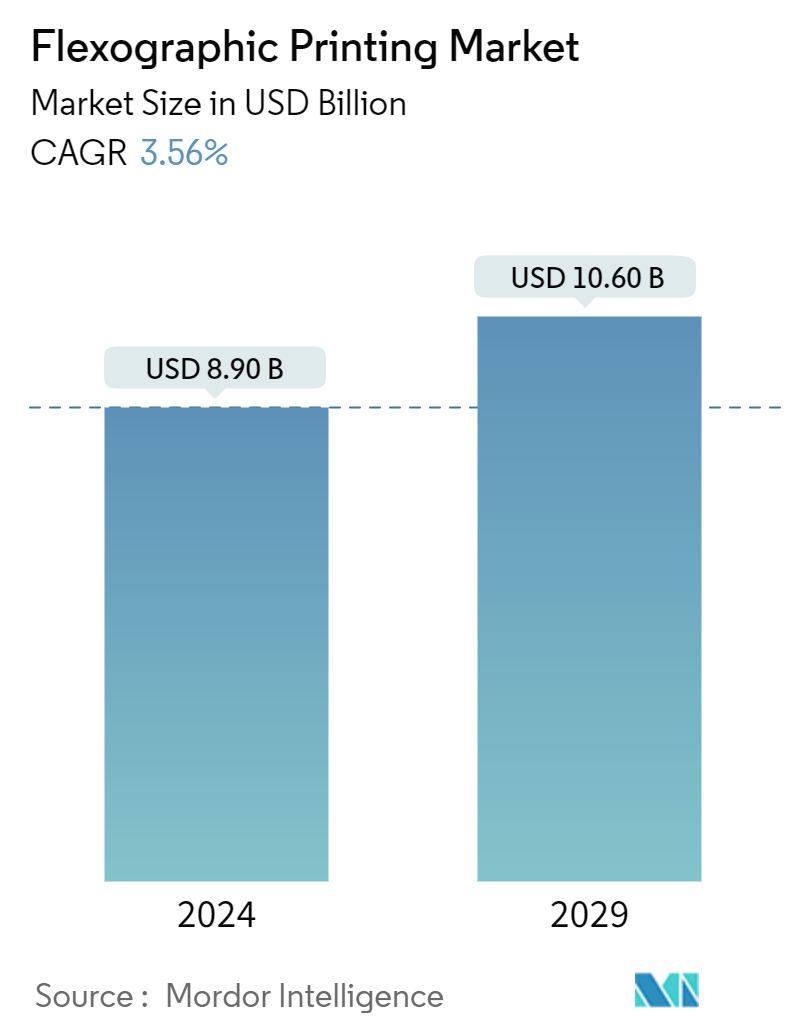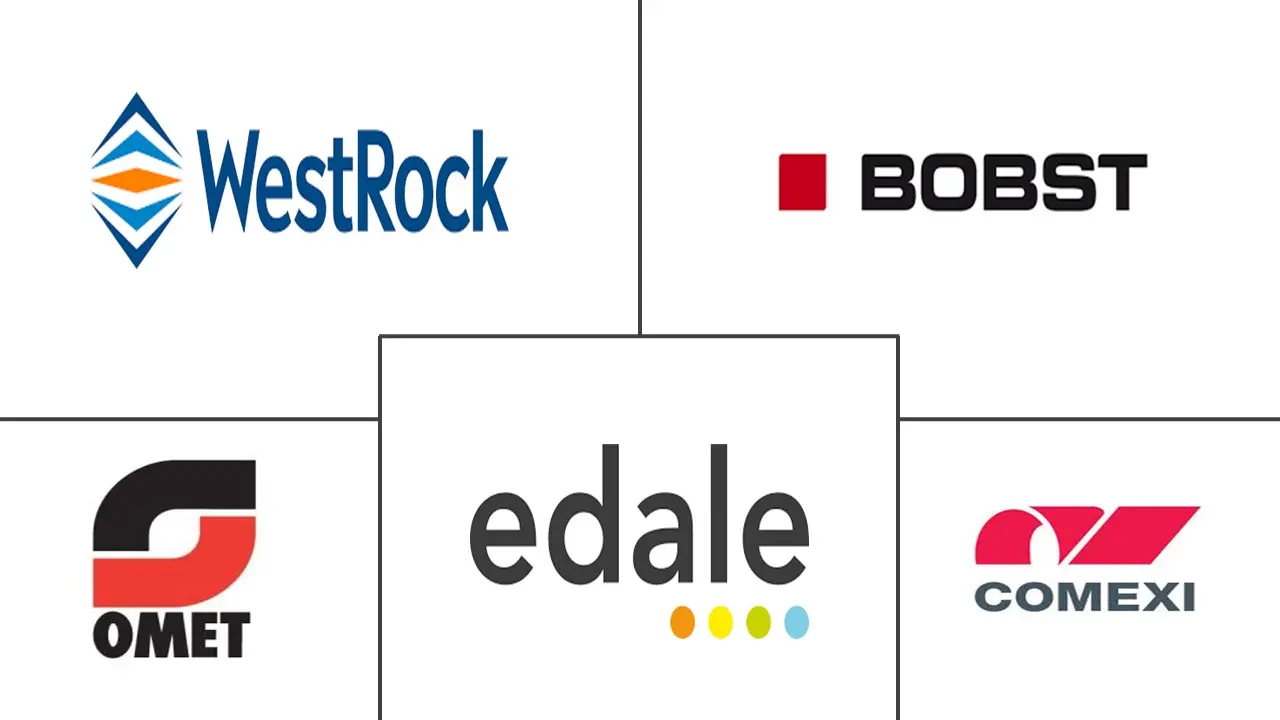Market Size of Flexographic Printing Industry

| Study Period | 2019 - 2029 |
| Market Size (2024) | USD 8.90 Billion |
| Market Size (2029) | USD 10.60 Billion |
| CAGR (2024 - 2029) | 3.56 % |
| Fastest Growing Market | Asia Pacific |
| Largest Market | Asia Pacific |
| Market Concentration | Medium |
Major Players
*Disclaimer: Major Players sorted in no particular order |
Flexographic Printing Market Analysis
The Flexographic Printing Market size is estimated at USD 8.90 billion in 2024, and is expected to reach USD 10.60 billion by 2029, growing at a CAGR of 3.56% during the forecast period (2024-2029).
Flexographic printing has garnered substantial attention in the packaging industry, finding applications in printing labels, cartons, and flexible plastics. The market is poised to benefit from the growth in industries like food and beverages.
- Flexographic printing has emerged as one of the swiftest-growing print processes. Its versatility in printing on diverse substrates has expanded its utility to various products. Technological advancements are increasingly shaping the flexographic printing machine market.
- The demand for high production speeds and efficient printing drives the flexographic printing machine market. As flexographic printing advances, it opens up a broad market for inks. The rising trend of printing on packaging, particularly in the food and consumer goods sectors, is fast-tracking the adoption of flexographic printing equipment.
- Flexographic printing presses offer a crucial advantage: the capability to deliver high-quality prints with vibrant colors and sharp images. This is achieved through the precision of ink transfer facilitated by the plates unique to flexographic printing. Furthermore, these presses excel in color registration, guaranteeing consistency across the printing run.
- Flexographic printing machines are witnessing a surge in demand, primarily due to their cost-effectiveness compared to alternatives. This efficiency is attributed to their quicker production rates and compatibility with fast-drying inks, especially when integrated with other systems. The e-commerce sectors, driven by a rising appetite for short-run, swift outputs, fuel the demand for flexographic printing. Flexography is the go-to method for printing materials ranging from corrugated cardboard to labels and metallic films.
- Historically reliant on labor, the printing industry saw a close correlation between turnover and employment trends. However, advancements like machinery design and digitalization have boosted productivity, decoupling growth from direct employment. Despite these strides, escalating raw material costs have constrained market players. Critical materials in flexographic printing encompass paper, ink, printing materials, and various chemicals.
Flexographic Printing Industry Segmentation
Flexographic printing is a printing process that utilizes flexible plates formed of rubber or plastic. Each plate, with its lightly extended image, is wheeled on a cylinder and applied with fast-drying ink. The substance to be printed on, or the substrate, is passed between the print plates and the roller, which uses pressure to keep the substrate against the plate. The study evaluates the revenue generated from selling various types of flexographic printing inks and equipment provided by vendors operating in the market.
The flexographic printing market is segmented by application (corrugated boxes, folding cartons, flexible packaging, labels, print media, and other applications) and geography (North America [United States and Canada], Europe [United Kingdom, Germany, France, Italy, Spain, and Rest of Europe], Asia-Pacific [China, India, Japan, Australia and New Zealand, and Rest of Asia-Pacific], Latin America, and Middle East and Africa). The market sizes and forecasts are provided in terms of value (USD) for all the above segments.
| By Application | |
| Corrugated Boxes | |
| Folding Carton | |
| Flexible Packaging | |
| Labels | |
| Print Media | |
| Other Applications |
| By Geography*** | |||||||
| |||||||
| |||||||
| |||||||
| Latin America | |||||||
| Middle East and Africa |
Flexographic Printing Market Size Summary
The flexographic printing industry is experiencing robust growth, driven by its increasing application in the packaging sector, particularly for labels, cartons, and flexible plastics. This growth is supported by the expanding food and beverage industries, which benefit from flexography's ability to print on non-porous substrates, making it ideal for food packaging. The versatility of flexographic printing, capable of handling various substrates such as paper, card, polymers, textiles, and metalized films, allows it to cater to a wide range of products, including packaging, wallpaper, and laminated tetra paks. The demand for high-speed, versatile printing machines that can operate on different surfaces and use both water-based and oil-based inks is expected to further propel the market. Additionally, the industry's ability to offer spot colors and value-added processes like cold foiling and embossing is making these features more mainstream, potentially reducing costs and enhancing appeal.
The market is also influenced by the rapid growth of the e-commerce sector, which has increased the demand for packaging solutions that flexographic printing provides, such as labels and corrugated cardboard. The logistics industry's expansion, a major consumer of packaging and print labels, is anticipated to boost market growth. Government initiatives to enhance the manufacturing sector and strategic partnerships by key players are expected to further drive the adoption of flexographic printing machines. The Asia Pacific region, particularly countries like China, India, and Japan, is leading the market due to rising commercial printing consumption. The market is moderately fragmented, with major players focusing on expanding their global presence through strategic collaborations and technological advancements, such as the integration of advanced press automation technologies and the introduction of new flexographic printing presses.
Flexographic Printing Market Size - Table of Contents
-
1. MARKET INSIGHTS
-
1.1 Market Overview
-
1.2 Industry Attractiveness - Porter's Five Forces Analysis
-
1.2.1 Bargaining Power of Suppliers
-
1.2.2 Bargaining Power of Buyers
-
1.2.3 Threat of New Entrants
-
1.2.4 Threat of Substitute Products
-
1.2.5 Intensity of Competitive Rivalry
-
-
1.3 Industry Value Chain Analysis
-
-
2. MARKET SEGMENTATION
-
2.1 By Application
-
2.1.1 Corrugated Boxes
-
2.1.2 Folding Carton
-
2.1.3 Flexible Packaging
-
2.1.4 Labels
-
2.1.5 Print Media
-
2.1.6 Other Applications
-
-
2.2 By Geography***
-
2.2.1 North America
-
2.2.1.1 United States
-
2.2.1.2 Canada
-
-
2.2.2 Europe
-
2.2.2.1 United Kingdom
-
2.2.2.2 Germany
-
2.2.2.3 France
-
2.2.2.4 Italy
-
2.2.2.5 Spain
-
-
2.2.3 Asia-Pacific
-
2.2.3.1 China
-
2.2.3.2 India
-
2.2.3.3 Japan
-
2.2.3.4 Australia and New Zealand
-
-
2.2.4 Latin America
-
2.2.5 Middle East and Africa
-
-
Flexographic Printing Market Size FAQs
How big is the Flexographic Printing Market?
The Flexographic Printing Market size is expected to reach USD 8.90 billion in 2024 and grow at a CAGR of 3.56% to reach USD 10.60 billion by 2029.
What is the current Flexographic Printing Market size?
In 2024, the Flexographic Printing Market size is expected to reach USD 8.90 billion.

